
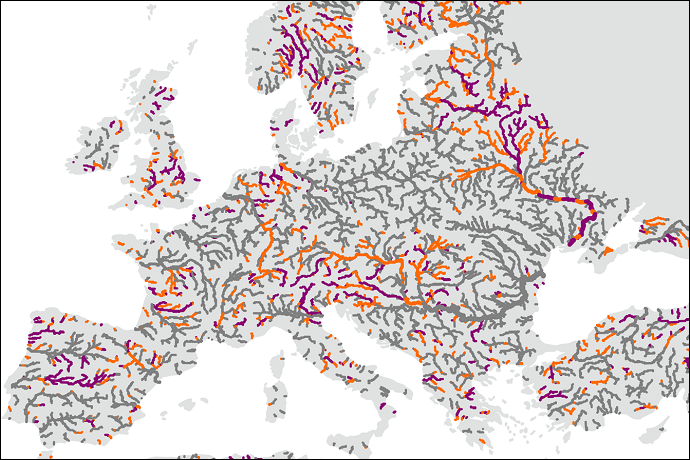
Data source: EFAS. Credit: CEMS/C3S/ECMWF.
One third of the European river network saw river flows exceeding the ‘high’ flood threshold in 2023, and the year saw a record number of days with ‘extreme heat stress’ in Europe, according to a report released by the EU’s Copernicus Climate Change Service (C3S), implemented by ECMWF, and the World Meteorological Organization (WMO).
The year was also the joint warmest or second warmest on record in Europe, depending on the dataset used, and it was the warmest on record globally.
The average sea-surface temperature for the ocean around Europe was the highest on record in 2023. It was also persistently high globally, reaching record levels for each month from April to December.
These findings, and many more, are reported in the annual European State of the Climate (ESOTC) report, which this year was issued jointly by C3S and the WMO.
Flooding
In 2023, Europe as a whole saw around 7% more precipitation than average. In one third of the European river network, river flows exceeded the ‘high’ flood threshold, and in 16%, they exceeded the ‘severe’ flood threshold.
Averaged across the European river network, river flows were the highest on record for December, with ‘exceptionally high’ flow in almost a quarter of the river network.
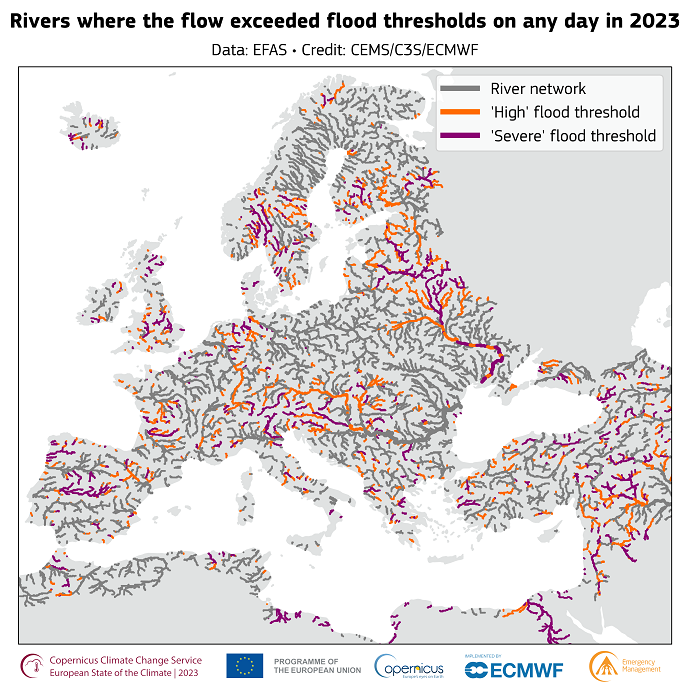
Map showing where river flow exceeded the ‘high’ (5-year return period) and ‘severe’ (20-year return period) flood thresholds on any day in 2023. Rivers with upstream areas larger than 1,000 km2 are shown in grey. They are coloured orange when river flow exceeded the ‘high’ flood threshold and purple when it exceeded the ‘severe’ flood threshold. Data source: EFAS. Credit: CEMS/C3S/ECMWF.
‘Extreme heat stress’
In the last 20 years, heat-related mortality has increased by around 30% in Europe, and heat-related deaths are estimated to have increased in 94% of European regions monitored.
Across Europe, there is an increasing number of days during which heat stress is experienced. In 2023, Europe experienced a record number of days with ‘extreme heat stress’, and parts of southern Europe experienced several days of ‘very strong heat stress', with the highest number of days seen over southern Spain.
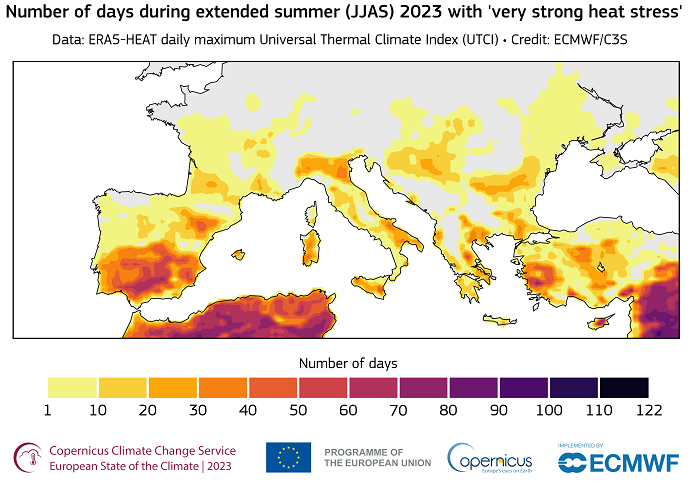
Number of days that experienced ‘very strong heat stress’ (UTCI between 38°C and 46°C) during June, July, August and September 2023. Heat stress indices represent the effect of the environment on the human body. Data source: ERA5-HEAT. Credit: C3S/ECMWF.
Joint-warmest/second-warmest year in Europe
For the WMO Regional Association VI (Europe) domain, the year 2023 was the joint warmest on record, together with 2020.
The temperature was 1.0°C above average with reference to 1991–2020, and 2.6°C above the pre-industrial level. Almost the entire region had above-average temperatures for the year as a whole, except for Scandinavia, Iceland and southeastern Greenland.
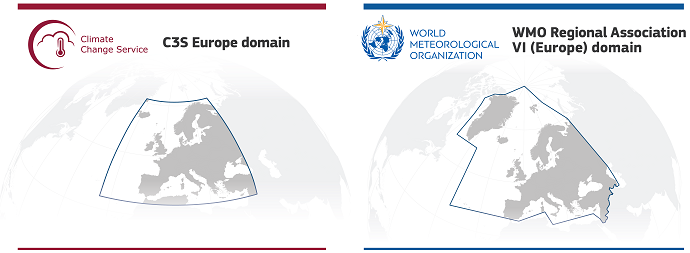
If the C3S domain for Europe is used, 2023 was the second-warmest year on record for Europe. It was 1.02–1.12°C above average with reference to 1991–2020, and 2.48–2.58°C above the pre-industrial level.
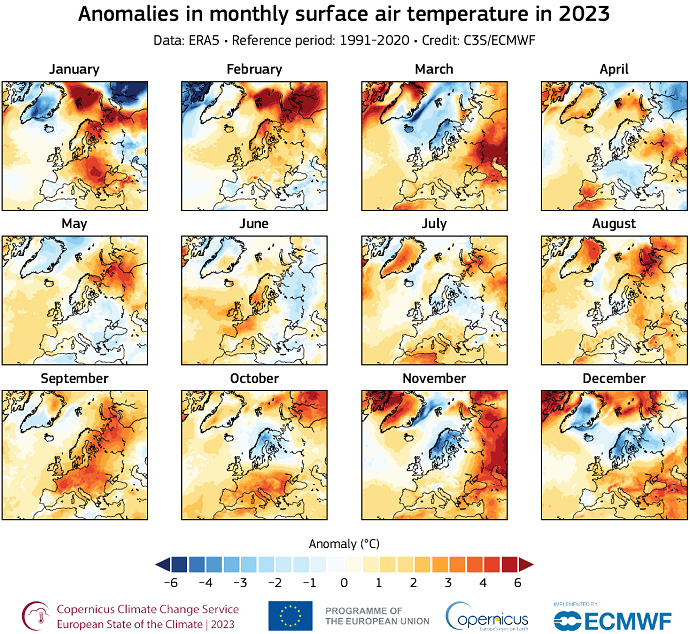
Anomalies in the monthly surface air temperature (°C) in 2023. Data source: ERA5. Credit: C3S/ECMWF.
Globally, 2023 was the warmest year on record. It was the first year in which every day exceeded 1°C above the pre-industrial level, and two days were, for the first time, more than 2°C warmer.
Sea-surface temperatures
For the year as a whole, the average sea-surface temperature for the ocean around Europe was the highest on record.
In June, the Atlantic Ocean west of Ireland and around the United Kingdom was impacted by a marine heatwave that was classified as ‘extreme’ and in some areas ‘beyond extreme’, with sea-surface temperatures as much as 5°C above average.
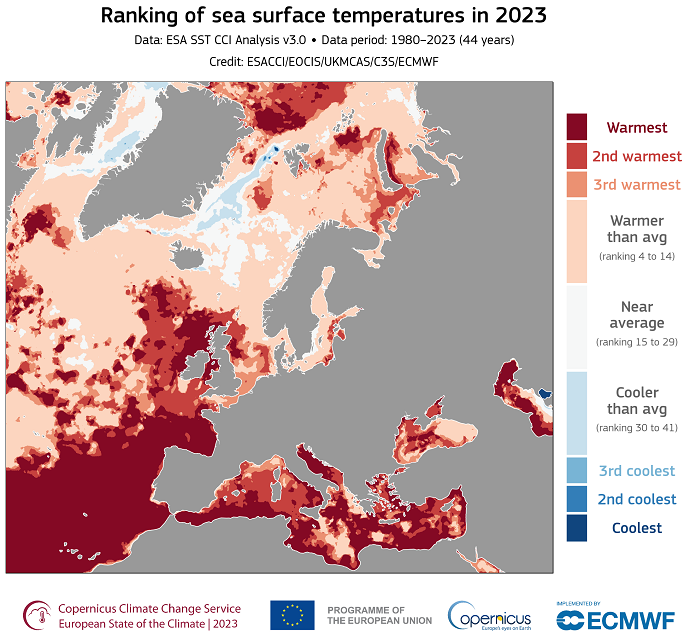
Ranking of the annual average sea-surface temperatures in 2023, relative to the 44-year period from 1980 to 2023. Darker shades indicate the highest and lowest rankings; the darkest red shows the areas where 2023 was the warmest year on record. Lighter shades indicate areas that were closer to average. Data source: ESA SST CCI Analysis v3.0. Credit: ESACCI/EOCIS/UKMCAS and C3S/ECMWF.
The sea-surface temperature was also persistently high globally, reaching record levels for each month from April to December, and breaking daily records.
More details
The full ESOTC report contains much more information, including on precipitation, wildfires, soil moisture, clouds and solar radiation, renewable energy resources, and flooding. There is also a section on climate policy and action with a focus on health. The report is available on the C3S website.
